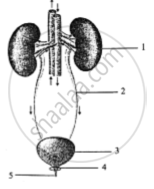Advertisements
Advertisements
प्रश्न
The diagram given alongside shows an endocrine gland in the human body. Study the diagram and answer the following questions:
 |
- Identify the gland. Write its specific location in the human body.
- Label the guidelines 1, 2 and 3 shown in the figure.
- Name any two secretions from part 1 and two from part 2.
- The deficiency of which hormone causes Diabetes insipidus? How is this condition different from Diabetes mellitus with respect to the abnormal substances present in the of urine.
उत्तर
- The pituitary gland is shown above. A small projection hangs from the base of the midbrain, below the hypothalamus.
-
- Anterior Pituitary
- Posterior Pituitary,
- Hypophyseal stalk
- Hormones produced by the anterior pituitary gland, including TSH. Posterior pituitary hormones include antidiuretic hormone (ADH) and oxytocin.
- Diabetes insipidus is caused by antidiuretic hormone deficiency. In this disease, the urine does not include glucose. However, in Diabetes mellitus, glucose is present in the urine.
संबंधित प्रश्न
The diagram given below represents an organ system in the human body. Study the same and answer the questions that follow :

Draw a neat, labelled diagram showing the longitudinal section of part 1.
The diagram give below represents an endocrine gland in the human body. Study the diagram and answer the following questions:
Why is the above gland referred to as the ‘Master gland’?
Label the following diagram :

What are tropic hormones?
What is adenohypophysis?
What are the hormones secreted by the posterior lobe of the pituitary gland? Mention the tissues on which they exert their effect.
Which of the following disorders is related to hyperactivity of the pituitary gland?
State whether true or false:
Pars distalis produces six trophic hormones.
Name the following:
Abnormalities caused due to hypersecretion of growth hormone.
Identify the gland with the help of following clue:
The gland is located in mid-brain below the hypothalamus.
